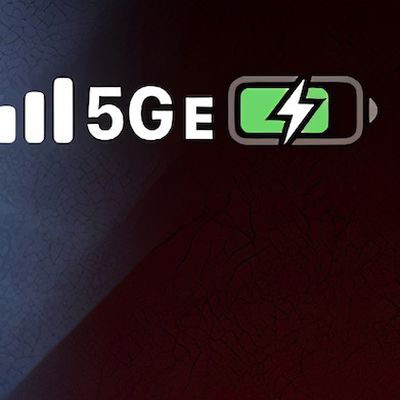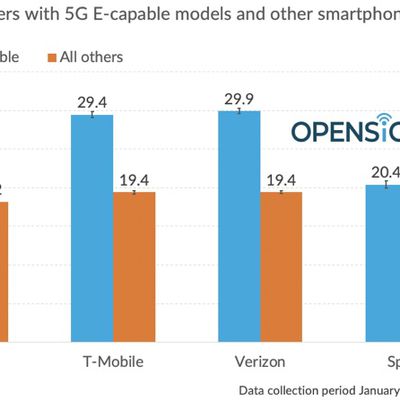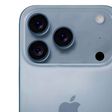After upgrading to iOS 12.2, the newest version of iOS, AT&T users began seeing a "5GE" icon in place of "LTE" for their cellular connection.
This is AT&T's misleading name for an enhanced 4G LTE network, and as explained in the guide below, is not actual 5G connectivity.
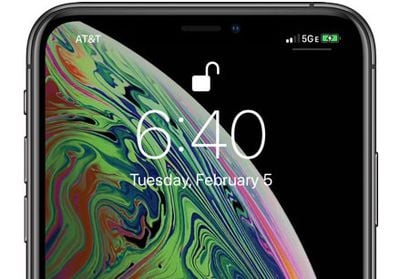
Why am I seeing a 5GE icon?
According to AT&T, customers who upgrade to iOS 12.2 or later will see the "5GE" icon when connected to what AT&T is calling a 5GE network. This is an AT&T-only thing, so it's limited to AT&T customers.
It's also only showing up on iOS devices running iOS 12.2 or later, but the 5GE icon has also previously rolled out to some Android devices.
What is 5GE?
5GE, or 5G "Evolution" is the name that AT&T is using in areas where 4G LTE technologies like three-way carrier aggregation, 4x4 MIMO, and 256 QAM are available. These features making existing wireless networks faster, provided your smartphone supports them.
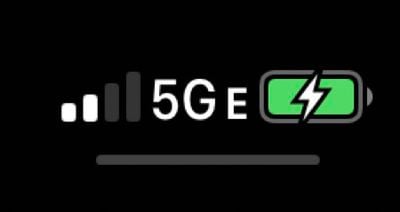
These are technologies that have already been in place on AT&T's network and networks from Verizon, Sprint, and T-Mobile. Your phone has probably already been connecting to AT&T's LTE networks with these capabilities even before AT&T added its 5GE icon.
AT&T, in fact, started rolling out support for these technologies in 2017, as did other U.S. carriers. AT&T says that in areas with these upgraded LTE technologies, customers can reach peak theoretical wireless speeds of up to 400 megabits per second, but in real-world usage that ends up being closer to 40 megabits per second.
These are LTE speeds that are available on many other carriers to customers using modern devices.
What's real 5G?
Real 5G networks offer much faster connection speeds and better performance. Carriers like AT&T, Verizon, Sprint, and T-Mobile are working on rolling out 5G mobile networks.
Actual 5G networks, when up and running with full coverage available, may be anywhere from 10 to 100 times faster than LTE networks. AT&T is working on true 5G, but it is not the same as the 5GE network being advertised.
So wait, my iPhone isn't connecting to a 5G network?
There are no iPhones in existence at the current time that are capable of connecting to a 5G network.
5G technology requires new modem hardware so until there is an iPhone with a 5G modem chip, no iPhones will work with 5G networks. Your current iPhone will not connect to 5G networks and will be limited to LTE.
I have an earlier version of iOS, will I see 5GE?
At this time, AT&T says that only devices running iOS 12.2 or later will display the 5GE icon. That doesn't mean your iPhone isn't taking advantage of AT&T's 5GE network, though, since the icon is merely cosmetic.
Where is 5GE available?
According to AT&T, "5GE" speeds are available in more than 400 markets, and by the first half of 2019, the upgraded LTE technology is expected to be available nationwide to more than 200 million customers.
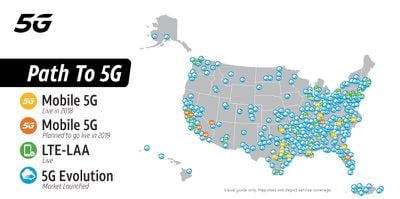
Why is AT&T misleading customers?
AT&T's justification is that 5G technology "is an evolution" rather than a single event, which is a rather weak argument.
AT&T wants customers to know that they're on an upgraded LTE network with faster speeds than were possible a few years back ahead of the rollout of 5G, but using 5G terminology is an underhanded and confusing way of doing it. In short, it's a marketing tactic that's essentially designed to fool customers into thinking they're connecting to a faster 5G network, capitalizing on all the buzz around 5G technology right now.
Are other carriers using misleading 5G branding?
T-Mobile has made fun of AT&T's decision to call its LTE networks 5G, while Sprint has called it "blatantly misleading."
didn’t realize it was this easy, brb updating pic.twitter.com/dCmnd6lspH — T-Mobile (@TMobile) January 7, 2019
Verizon has taken out full page ads in major newspapers like The New York Times and has warned about the dangers of confusing terms.
"The potential for 5G is awesome, but the potential to over-hype and under-deliver on the 5G promise is a temptation that the wireless industry must resist."
"Verizon is making this commitment today: We won't take an old phone and just change the software to turn the 4 in the status bar into a 5. We will not call our 4G network a 5G network if customers don't experience a performance or capability upgrade that only 5G can deliver.
Sprint has also taken out full-page ads bashing AT&T's deception and has gone so far as to sue AT&T for the misleading branding. Verizon, Sprint, and T-Mobile, the other three major carriers in the U.S., have no plans to introduce similarly confusing branding ahead of the rollout of 5G.
When will AT&T actually have a real 5G network?
Technically, AT&T has already started rolling out real 5G service in parts of 12 cities: Atlanta, Charlotte, N.C., Dallas, Houston, Indianapolis, Jacksonville, Fla., Louisville, Ky., Oklahoma City, New Orleans, Raleigh, N.C., San Antonio and Waco, Texas.
AT&T plans to expand real 5G coverage to additional cities that include Las Vegas, Los Angeles, Nashville, Orlando, San Diego, San Francisco, and San Jose during the first half of 2019. AT&T's 5G networks are denoted by a "5G+" icon.
But remember, even with 5G networks available from AT&T, devices also need to incorporate 5G chips to use them.
AT&T is also confusingly rolling out another network feature called LTE-LAA, a second upgraded version of LTE with peak theoretical speeds of 1 gigabit per second.
The National Advertising Review Board recommended that AT&T discontinue its 5GE marketing claims because it could be misleading to consumers, but AT&T said that it "respectfully disagrees" with the decision and has no plans to remove the 5GE icon from smartphones because it's not considered advertising.
When will my iPhone work with 5G networks?
Apple plans to introduce 5G iPhones in 2020 with the 2020 iPhone 12 lineup.
Some Android smartphone manufacturers, including Samsung, started releasing 5G smartphones in 2019. Carriers have also started rolling out 5G networks, but it will take several years for 5G to get off the ground and for coverage to spread across the United States.


